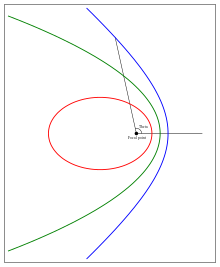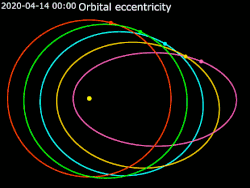
Back Eksentrisiteit (sterrekunde) Afrikaans Excentricidat AN انحراف مداري Arabic Эксцэнтрысітэт арбіты Byelorussian Ексцентрицитет (орбита) Bulgarian কক্ষীয় উৎকেন্দ্রিকতা Bengali/Bangla Excentricitat orbital Catalan Excentricita dráhy Czech Excentricitet (astronomi) Danish Exzentrizität (Astronomie) German

Elliptic (eccentricity = 0.7)
Parabolic (eccentricity = 1)
Hyperbolic orbit (eccentricity = 1.3)

0 · 0.2 · 0.4 · 0.6 · 0.8
| Part of a series on |
| Astrodynamics |
|---|
In astrodynamics, the orbital eccentricity of an astronomical object is a dimensionless parameter that determines the amount by which its orbit around another body deviates from a perfect circle. A value of 0 is a circular orbit, values between 0 and 1 form an elliptic orbit, 1 is a parabolic escape orbit (or capture orbit), and greater than 1 is a hyperbola. The term derives its name from the parameters of conic sections, as every Kepler orbit is a conic section. It is normally used for the isolated two-body problem, but extensions exist for objects following a rosette orbit through the Galaxy.